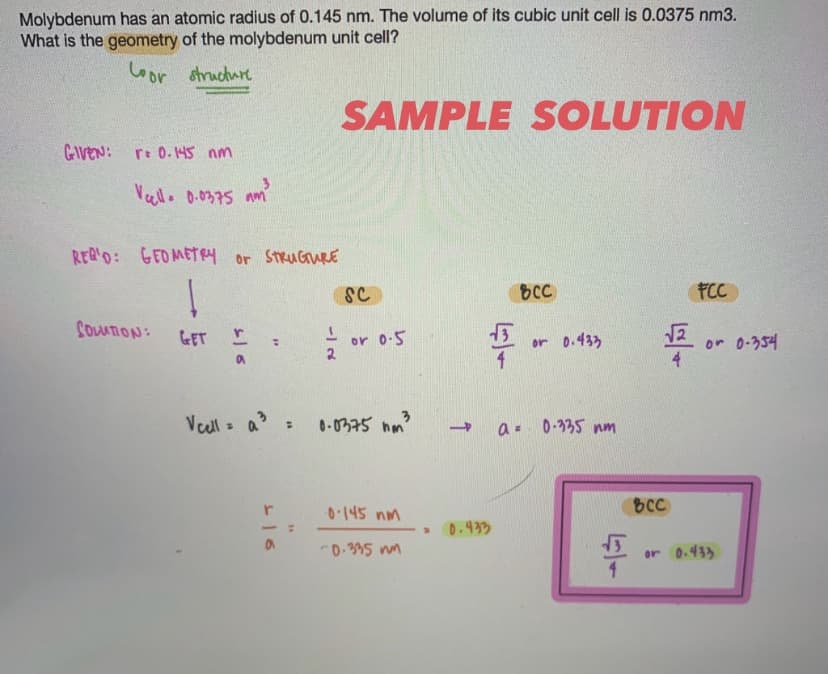25) X-ray diffraction (XRD) is an analytical method of studying solids. Find the identity of an unknown metal whose unit cell edge is 0.303 nm measured by XRD and density is 6.1 g/mL. A. zinc (MW=65) B. copper (MW=63.5) C. iron (MW=56) D. vanadium (MW=51)
25) X-ray diffraction (XRD) is an analytical method of studying solids. Find the identity of an unknown metal whose unit cell edge is 0.303 nm measured by XRD and density is 6.1 g/mL. A. zinc (MW=65) B. copper (MW=63.5) C. iron (MW=56) D. vanadium (MW=51)
Chemistry for Engineering Students
4th Edition
ISBN:9781337398909
Author:Lawrence S. Brown, Tom Holme
Publisher:Lawrence S. Brown, Tom Holme
Chapter8: Molecules And Materials
Section: Chapter Questions
Problem 8.16PAE: 8.16 Iridium forms a face-centered cubic lattice, and an iridium atom is 271.4 pm in diameter....
Related questions
Question
SHOW YOUR COMPLETE SOLUTION
hint : its BCC

Transcribed Image Text:Molybdenum has an atomic radius of 0.145 nm. The volume of its cubic unit cell is 0.0375 nm3.
What is the geometry of the molybdenum unit cell?
Coor structure
SAMPLE SOLUTION
CAVEN:
r: 0.145 nm
Vello 0.0375 am
REQ'D: GEO METRy or StRuGuRE
SC
bCC
FCC
CouATION:
GET
or o-5
2.
or 0-354
4
or 0.433
Veull = a :
0-0375 hm
a- 0-335 nm
0.145 nm
BCC
0.433
D-395 nn
or 0.433

Transcribed Image Text:25) X-ray diffraction (XRD) is an analytical method of studying solids. Find the identity of an
unknown metal whose unit cell edge is 0.303 nm measured by XRD and density is 6.1 g/mL.
A. zinc (MW=65)
B. copper (MW=63.5)
C. iron (MW=56)
D. vanadium (MW=51)
Expert Solution
This question has been solved!
Explore an expertly crafted, step-by-step solution for a thorough understanding of key concepts.
Step by step
Solved in 2 steps with 2 images

Knowledge Booster
Learn more about
Need a deep-dive on the concept behind this application? Look no further. Learn more about this topic, chemistry and related others by exploring similar questions and additional content below.Recommended textbooks for you

Chemistry for Engineering Students
Chemistry
ISBN:
9781337398909
Author:
Lawrence S. Brown, Tom Holme
Publisher:
Cengage Learning

Physical Chemistry
Chemistry
ISBN:
9781133958437
Author:
Ball, David W. (david Warren), BAER, Tomas
Publisher:
Wadsworth Cengage Learning,

Chemistry & Chemical Reactivity
Chemistry
ISBN:
9781337399074
Author:
John C. Kotz, Paul M. Treichel, John Townsend, David Treichel
Publisher:
Cengage Learning

Chemistry for Engineering Students
Chemistry
ISBN:
9781337398909
Author:
Lawrence S. Brown, Tom Holme
Publisher:
Cengage Learning

Physical Chemistry
Chemistry
ISBN:
9781133958437
Author:
Ball, David W. (david Warren), BAER, Tomas
Publisher:
Wadsworth Cengage Learning,

Chemistry & Chemical Reactivity
Chemistry
ISBN:
9781337399074
Author:
John C. Kotz, Paul M. Treichel, John Townsend, David Treichel
Publisher:
Cengage Learning

Chemistry by OpenStax (2015-05-04)
Chemistry
ISBN:
9781938168390
Author:
Klaus Theopold, Richard H Langley, Paul Flowers, William R. Robinson, Mark Blaser
Publisher:
OpenStax

General Chemistry - Standalone book (MindTap Cour…
Chemistry
ISBN:
9781305580343
Author:
Steven D. Gammon, Ebbing, Darrell Ebbing, Steven D., Darrell; Gammon, Darrell Ebbing; Steven D. Gammon, Darrell D.; Gammon, Ebbing; Steven D. Gammon; Darrell
Publisher:
Cengage Learning

Chemistry & Chemical Reactivity
Chemistry
ISBN:
9781133949640
Author:
John C. Kotz, Paul M. Treichel, John Townsend, David Treichel
Publisher:
Cengage Learning